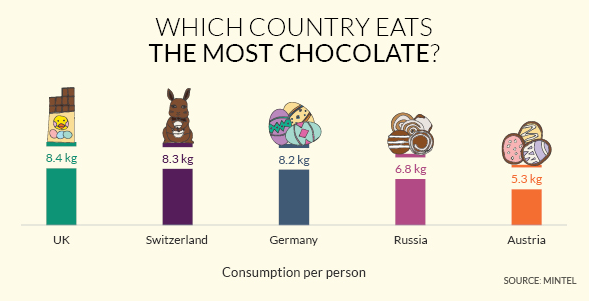Chocolate production and consumption on the rise across the globe, says new data
Brits consumed the most chocolate of any country in 2017

Your support helps us to tell the story
From reproductive rights to climate change to Big Tech, The Independent is on the ground when the story is developing. Whether it's investigating the financials of Elon Musk's pro-Trump PAC or producing our latest documentary, 'The A Word', which shines a light on the American women fighting for reproductive rights, we know how important it is to parse out the facts from the messaging.
At such a critical moment in US history, we need reporters on the ground. Your donation allows us to keep sending journalists to speak to both sides of the story.
The Independent is trusted by Americans across the entire political spectrum. And unlike many other quality news outlets, we choose not to lock Americans out of our reporting and analysis with paywalls. We believe quality journalism should be available to everyone, paid for by those who can afford it.
Your support makes all the difference.Most people love chocolate but it turns out no one does more than the Brits - with the average Brit found to have consumed 8.4 kg of chocolate in 2017, according to new data.
However, while the amount may seem excessive, the Brits aren’t the only ones consuming chocolate at an increasing rate.
Chocolate consumption around the world is on the rise, according to Mintel Global New Products Database (GNPD), which found that in the past year alone, Easter chocolate production has risen by 23 per cent.
This is in part due to the importance of “seasonal products as a whole,” as holiday-themed chocolate comprised 23 per cent of global chocolate launches - with Germany and the US leading in terms of “new chocolate production.”
When it comes to Easter eggs and Easter bunnies, chocolate-manufacturing giant Brazil led the way - accounting for 11 per cent of Easter egg production in 2017, according to the new data, and followed closely behind by South Africa, Germany, the UK, and France.
Chocolate Easter treats are also an excuse to experiment - in the UK, gin and tonic-flavoured eggs have replaced the popular beer-flavoured eggs of the past.
And while indulging in a bit of chocolate does not require a special occasion, it does typically require an element of self-control to keep from eating multiple Easter bunnies - which is why it comes as no surprise chocolate “bites” have become increasingly popular.

According to Mintel GNPD, production of chocolate “bites” has risen by 50 per cent in the last five years, with “thins” following close behind at 48 per cent.
Of the decreased chocolate sizes, Marcia Mogelonsky, director of insight at Mintel Food and Drink said: “The growth of bite-sized chocolate points to the ongoing trend of permissible indulgence. Pre-measured, 100 calorie packs of chocolate or other treats have fallen from favour as consumers move away from diets that focus on strict calorie counts. Offering consumers a ‘bite’ or a ‘thin’ piece of chocolate provides an easier way to measure intake, and one that allows for a bit of wiggle room.”
But because chocolate is versatile and capable of following any trend, production of vegan chocolate has also increased across Europe, according to the data - which found more than half of chocolate-eaters in Spain, France, and Poland interested in vegan chocolate.
With Easter just days away, now is your chance to stock up on the numerous chocolatey treats available - or you can wait until the day after Easter when the chocolate will likely be discounted.
Join our commenting forum
Join thought-provoking conversations, follow other Independent readers and see their replies
Comments